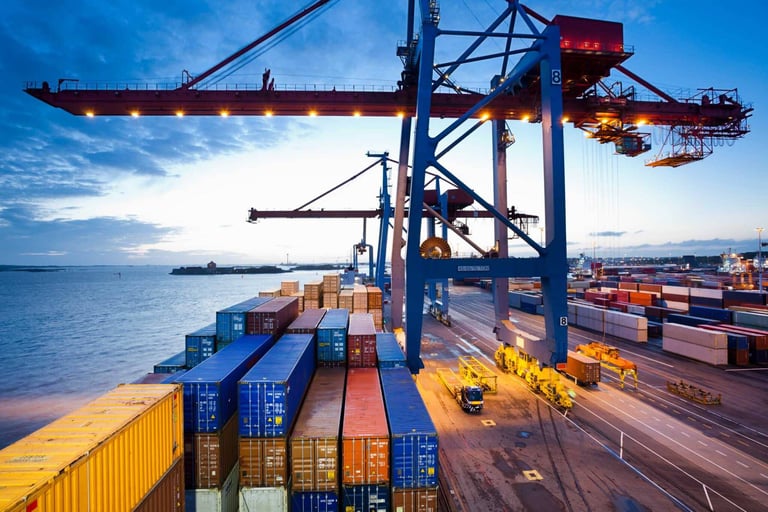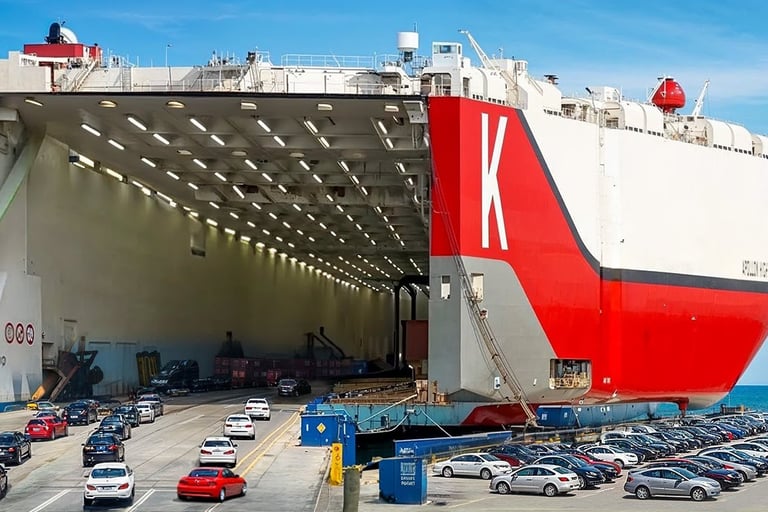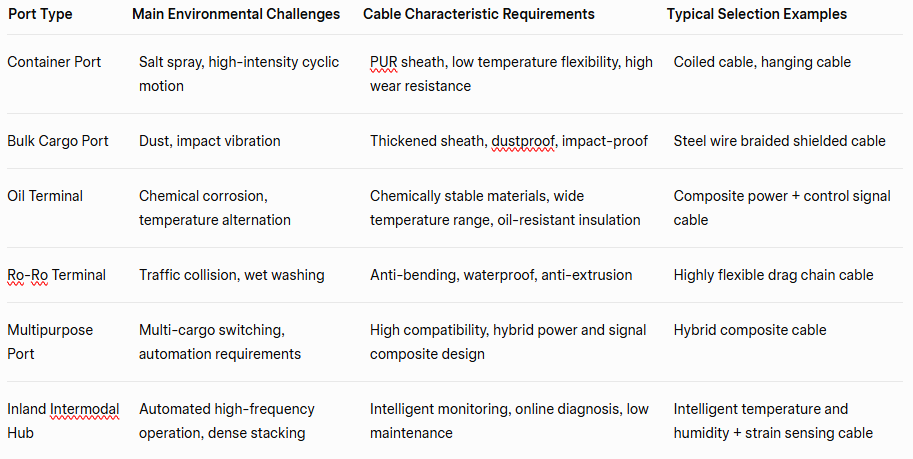📞+86 153 7530 2641 📧 hongjing.Wang@feichuncables.com

From Bulk Terminals to Smart Ports: Why Crane Cables Are Indispensable
From container ports to automated terminals, crane and marine cables are essential for powering, controlling, and securing lifting systems. Learn why high-performance crane and marine cable solutions are the backbone of efficient, safe operations in today’s demanding port environments.
hongjing.Wang@Feichun
7/4/20255 min read
Why Different Types of Ports Need Crane Cables: A Comprehensive Analysis
Introduction
In the bustling world of global trade, ports serve as critical nodes for the movement of goods, from containers to bulk commodities, oil, vehicles, and more. At the heart of these operations are cranes, the workhorses that lift, move, and stack cargo with precision and efficiency. Crane cables, often referred to as the "nerve hub" of port operations, are essential for delivering reliable power and control signals to these machines. As ports evolve to handle increasing cargo volumes and embrace automation, the demand for advanced crane cables is surging. This article explores why different types of ports—container terminals, bulk terminals, oil and chemical terminals, Ro-Ro terminals, multipurpose ports, and intermodal terminals—require specialized crane cables. It delves into their core functions, selection criteria, real-world applications, and the future trends shaping the port cable market, driven by automation and intelligent technologies.


Main Port Types and Characteristics
Ports are diverse in their operations, each designed to handle specific types of cargo and facing unique environmental challenges. Understanding these differences is key to selecting the right crane cables.
Container Terminals: These ports manage containerized cargo, using cranes like Ship-to-Shore (STS) and Rubber-Tired Gantry (RTG) or Rail-Mounted Gantry (RMG) cranes. They operate in coastal environments, facing salt spray and high-intensity cyclic motion.
Bulk Terminals: Handling commodities like coal, grain, or iron ore, these ports use grab cranes and belt conveyor systems. Dust and impact vibration are significant challenges.
Oil & Chemical Terminals: These ports deal with liquid cargo, requiring cranes for pipeline support and tank filling. Chemical corrosion and extreme temperature variations are common.
Ro-Ro Terminals: Roll-on/Roll-off terminals manage vehicles and rollable cargo, using vehicle-mounted boarding bridges and platform cranes. Cables must withstand traffic collisions and wet conditions.
Multipurpose Ports: These versatile ports handle various cargo types, requiring flexible cranes and cables that can adapt to diverse operational needs.
Intermodal Terminals: Facilitating cargo transfer between transport modes, these terminals use automated systems like container jacking and Automatic Stacking Cranes (ASC), demanding cables for high-frequency operations.






Overview of Crane Applications in Various Ports
Each port type employs specific cranes tailored to its cargo and operational requirements, each with distinct cable needs:
Container Ports: STS cranes load and unload containers from ships, while RTG/RMG cranes manage yard operations. Cables must support high-speed reeling (up to 300 m/min) and frequent movement.
Bulk Cargo Ports: Grab cranes and belt conveyor lifting arms handle bulk materials, requiring cables resistant to abrasion and dust.
Oil Terminals: Pipeline support arms and tank filling devices operate in hazardous environments, necessitating explosion-proof cables compliant with standards like ATEX.
Ro-Ro Terminals: Vehicle-mounted boarding bridges and platform cranes require highly flexible cables to endure constant bending and wet conditions.
Multipurpose Ports: Gantry and boom cranes handle diverse cargo, needing versatile cables with hybrid power and signal capabilities.
Inland Intermodal Transport: Automated stacking cranes and container jacking systems rely on cables supporting high automation, including data transmission for real-time monitoring.
Core Value of Crane Cables in Ports
Crane cables are indispensable for port operations, delivering critical functions:
Power Transmission: Provide stable power for crane movements, including lifting, rotation, and travel, ensuring uninterrupted operations.
Signal and Control: Enable real-time communication between Programmable Logic Controllers (PLCs), sensors, and inverters for precise control.
Durability and Safety: Designed to withstand harsh conditions like corrosion, high-frequency bending, UV exposure, and meet fire protection standards (e.g., Low Smoke Zero Halogen - LSZH).
Maintenance and Replacement: Modular designs and conditional replacement strategies minimize downtime and maintenance costs.
Key Points of Cable Selection in Different Port Scenarios
Selecting the appropriate crane cable involves matching cable characteristics to the environmental and operational challenges of each port type. The table below outlines these considerations:


Case Analysis: Differentiated Needs of Crane Cables in Different Ports
Case 1: Singapore Port – Automated Lifting System and Composite Cables
Singapore’s Tuas Port, set to be the world’s largest fully automated container terminal by the 2040s, exemplifies the integration of advanced crane cables in automated systems. With over 1,000 automated yard cranes and Automated Guided Vehicles (AGVs), the port relies on composite cables that combine power and data transmission. These cables ensure seamless operation of automated quay cranes and AGVs, enhancing efficiency and safety. The port’s private 5G network further underscores the need for hybrid cables to support digitalization.
Case 2: Australian Bulk Cargo Port – High Mechanical Strength Drum Cables
Australian bulk cargo ports, such as those handling coal and iron ore, face intense mechanical stress and dusty environments.These cables offer high abrasion resistance and can withstand impact vibrations, making them ideal for grab cranes and belt conveyor systems. Their durability reduces maintenance frequency, ensuring continuous operation in high-throughput ports like those in Western Australia.
Case 3: Middle Eastern Liquid Port – Explosion-Proof Drag Chain Cables
Liquid ports in the Middle East, handling oil and chemicals, operate in hazardous environments where safety is paramount. Explosion-proof drag chain cables, compliant with ATEX standards, are essential. These cables are used in pipeline support arms and tank filling devices, ensuring safe and reliable operation in ports like those in the UAE and Saudi Arabia.
Future Trends: Intelligent Ports and Cable Technology Innovation
The port industry is undergoing a transformation driven by automation, digitalization, and sustainability, which are reshaping the crane cable market:
Automation and Unmanned Operations: Ports like Singapore’s Tuas are adopting automated cranes and AGVs, increasing the demand for cables that support high-frequency operations and real-time data transmission. Hybrid cables combining power and fiber-optic signals are becoming standard to meet these needs.
Hybrid Cables: Optical fiber and copper core hybrid cables are gaining traction, enabling simultaneous power and data transmission. These cables support the digital infrastructure of smart ports, facilitating remote monitoring and control.
Intelligent Cables: Emerging “smart” cables with embedded sensors for monitoring temperature, strain, and wear are set to revolutionize maintenance. These cables enable predictive maintenance, reducing downtime and enhancing operational efficiency.
Sustainability and Durability: The push for greener ports is driving demand for eco-friendly cables, such as LSZH cables, which reduce environmental impact. Durable cables that withstand harsh conditions also lower replacement costs, aligning with sustainability goals.
The market for port cables is expected to grow as ports invest in automation and smart technologies. According to industry insights, the shift towards electrification and digitalization, as seen in projects like Tuas Port, will drive demand for advanced cables. However, challenges such as higher costs and compatibility with existing systems may slow adoption in some regions.
Conclusion
Crane cables are the lifeline of port operations, ensuring the seamless functioning of cranes across diverse port types. From container terminals battling salt spray to oil terminals requiring explosion-proof solutions, each port demands cables tailored to its unique challenges. As ports worldwide embrace automation and digitalization, the crane cable market is poised for significant growth. Hybrid and intelligent cables will play a pivotal role in meeting the demands of smart ports, enhancing efficiency, safety, and sustainability. By selecting cables that align with specific environmental and operational needs, port operators can optimize performance and prepare for the future of global trade.
How to Reach Us
Get in Touch
SiteMap
Product Catalogue
Reeling Cable
Festoon Cable
Shore Power Cable




Scan to add us on WeChat
